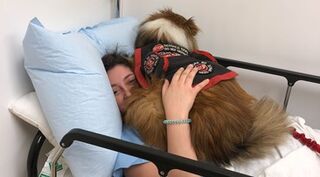Psychiatry
Why Are Psychiatric Service Dogs So Uncommon?
Partnership with a psychiatric service dog remains hard to access for many.
Posted March 29, 2022 Reviewed by Ekua Hagan
Key points
- Psychiatric service dogs (PSDs) are trained to perform helpful tasks in response to their owner's symptoms.
- PSDs can be effective for many psychiatric disorders other than PTSD, such as panic disorder, general anxiety disorder, and schizophrenia.
- While PSDs are not "magic bullets," they have been known to reduce the amount and frequency of psychiatric medication a person needs.
By guest blogger Miranda Stein (and Milo) with co-author Dr. Katherine Compitus.
I am a 27-year-old woman. I am capable, I take care of others, I have a college degree, and am halfway through a graduate school degree. I’m smart and I’m strong and I take care of myself. Most of the time. But sometimes I’m 18. Or 13. Or 5. Sometimes I’m a little girl paralyzed by the things I see behind my eyes. Sometimes all I can do is rock and cry.
At those times, Milo makes the memories go. He curls up by my chest. And he waits with me, rides out the storm. And slowly, my focus shifts from the terror in my mind and the spasms in my body to the twitching of his paws against my arms. I breathe his scent in deeply and he looks into my eyes. His eyes are all I see, guiding me to safety. My breathing slows towards his and the adrenaline retreats. Back in the present, I’m me again.

What's a Psychiatric Service Dog (PSD)?
Psychiatric Service Dogs are most often associated with combat veterans who have post-traumatic stress disorder, but in recent years, a wide variety of people have discovered the impact that partnering with a psychiatric service dog can have on one’s quality of life and independence. PSDs are gaining popularity amongst people with non-combat-related PTSD, such as survivors of assault and domestic violence (Judy, 2011; Jacobson, 2015; Moore, 2020).
People with diagnoses including depressive disorders, anxiety disorders, panic disorder, bipolar disorders, schizophrenia, agoraphobia, eating disorders, obsessive-compulsive disorder, schizoaffective disorder, and personality disorders have been able to find relief from symptoms and many have even needed less medication after partnering with PSDs (Esnayra and Love, 2012).
I would have needed to take medication during the episode described above if I had not had Milo with me. PSDs are not magic bullets and I still sometimes need to take medication, but I have been able to reduce the amount and frequency that I need to take it since partnering with Milo. My psychiatrist prefers me to take the lowest effective dose, and I do too, as many medications can have serious side effects including the possibility of addiction (Olson, 2020).
Who can benefit from a PSD?
PSDs can be effective for so many other psychiatric disorders than PTSD. Many of the symptoms and actions that PSDs perform in response (called “tasks”) overlap across diagnoses. For example, Milo performs a task for me called “block,” where if we are out in public together, and someone is standing too close to me and I begin to feel anxious or unsafe, Milo will step between us, causing the other person to take a step back and creating a physical barrier for me.

This task would also be helpful to a person with agoraphobia, who may feel so overwhelmed by anxiety and fears of being trapped in a crowd in a public space that they may feel completely unable to leave their home at all (Morrison et al., 2014). Having a PSD to perform block and create that space could allow such people to feel confident and secure enough to leave their homes (Esnayra & Love, 2012).
Another task Milo performs for me is grounding, which is really several tasks in one, described in the passage above. Grounding refers to orienting oneself to the present (usually through exercises or actions aimed at observing the senses) to alleviate anxiety, panic, intrusive thoughts or memories, and hallucinations (Briere et al., 2015).
Grounding with PSDs can involve different tasks for different people, but for me, it involves visual, tactile, and olfactory stimulation. Milo performs “watch,” by seeking sustained eye contact and various deep pressure therapy (DPT) tasks by laying on or against me or leaning against me. He does not perform any tasks to provide olfactory stimulation, at least not on purpose (I don’t think!).
Grounding is helpful to orient me to the present when I am experiencing intrusive memories, but it also helps when I am experiencing anxiety or a panic attack. People with panic disorder, general anxiety disorder, schizophrenia, or other disorders involving psychoses can all benefit from grounding and thus from PSDs (Esnayra & Love, 2012).

DPT and tactile stimulation can also be used for many purposes other than grounding, and therefore can be helpful to a wide variety of people. Check out the tables below to see some other ways that those tasks can be used, as well as a whole bunch of other tasks that PSDs can be trained to perform for a whole bunch of disorders and symptoms!
Why are PSDs still uncommon?
PSDs are extremely versatile and have the power to change peoples’ lives in ways we often couldn’t even imagine. So, why are more people not being partnered with PSDs?
We do need more research to support the success and effectiveness of PSDs, as most of the research currently available has been done with combat veterans presenting with PTSD. PSDs are also incredibly expensive and inaccessible to the people who need them.
Buying a pre-trained PSD costs tens of thousands of dollars—and they are rarely subsidized (Waltzer, 2020). This doesn’t even include the cost of vet and food bills, which can be thousands of dollars a year (Waltzer, 2020). Plus, waitlists can be months or years long (Walther et al., 2019). Even if one trains the dog themselves, it can cost thousands of dollars for classes and private training (Ellingson, 2012).
We need more funding to help people pay for PSDs and the programs that train them. Living a meaningful life regardless of psychiatric disabilities should be an attainable goal for everyone. We do deserve dogs!
Check out these links to learn more about the psychiatric service dog partnership process if you think you could benefit from a partnership and/or ask a mental health professional that you trust for more information:
- "Psychiatric Service Dog Partners: a Non-Profit Organization Founded by Handlers of PSDs for Current, Aspiring, and Potential Handlers"—a hub of information, news, and articles; host of private online peer guidance group; advocate for PSD teams.
- "How to Get a Service Dog for Depression or Anxiety (and How Much It Costs)"
- "Training a Service Dog for Public Access"
- "Service Dogs For Sexual Assault Survivors"
- "'It Fills My Soul,' One Woman's Goal to Train Psychiatric Service Dogs for Survivors"
References
Briere, J., & Scott, C. (2015). Dealing with acute intrusion: Grounding. In Principles of trauma therapy a guide to symptoms, evaluation, and treatment (2nd ed., pp. 134–136). chapter section, Sage.
Ellingson, K. (2012). Training a service dog for public access privileges. Speak Dog. https://speakdogtricities.com/uncategorized/training-a-service-dog-for-…
Esnayra, J. & Love, C. (2012). A survey of mental health patients utilizing psychiatric service dogs. Psychiatric Service Dog Society. https://veteranvoice.info/ARCHIVE/info_12apr_A%20Survey%20of%20Mental%2…
Jacobson, R. (2015, January 5). Service Dogs for Sexual-Assault Survivors. The Atlantic. https://www.theatlantic.com/health/archive/2014/11/service-dogs-for-sex….
Moore, C. J. (2020, January 9). 'It fills my soul': One woman's goal to train psychiatric service dogs for survivors. 'It fills my soul': One woman's goal to train psychiatric service dogs for survivors - The State News. https://statenews.com/article/2020/01/it-fills-my-soul-one-womans-goal-….
Morrison, J. (2014). Chapter 4: Anxiety Disorders; F40.00 [300.22] Agoraphobia. In DSM-5 MADE EASY: the clinician's guide to diagnosis (pp. 179–182). chapter section, Guilford Publications.
Olson, J. M. (2020). Clinical pharmacology made ridiculously simple. MedMaster, Inc.
Psychiatric Service Dog Partners. (2015). Work and task list. Psychiatric Service Dog Partners: Dogs Saving Lives. https://www.psychdogpartners.org/wp-content/uploads/2015/08/2015-Work-a….
Rodriguez, K. E., LaFollette, M. R., Hediger, K., Ogata, N., & O’Haire, M. E. (2020). Defining the PTSD Service Dog Intervention: Perceived Importance, Usage, and Symptom Specificity of Psychiatric Service Dogs for Military Veterans. Frontiers in Psychology, 11. https://doi.org/10.3389/fpsyg.2020.01638
Walther, S., Yamamoto, M., Thigpen, A. P., Willits, N. H., & Hart, L. A. (2019). Geographic Availability of Assistance Dogs: Dogs Placed in 2013-2014 by ADI- or IGDF-Accredited or Candidate Facilities in the United States and Canada, and Non-accredited U.S. Facilities. Frontiers in veterinary science, 6, 349. https://doi.org/10.3389/fvets.2019.00349
Waltzer, S. (2019). Financial means as a requisite to obtaining benefits: Routine service dog expenses as a disability benefit for veterans with service connected disabilities. Administrative Law Review, 71(4). http://www.administrativelawreview.org/wp-content/uploads/2019/12/ALR_7…
Wisconsin’s Violence Against Women with Disabilities and Deaf Women Project, & Judy, A. (2011, September). Victims/Survivors who use service animals: an updated background paper and sample policy for domestic violence and sexual assault programs. Disability Rights Wisconsin. http://www.disabilityrightswi.org/wp-content/uploads/2018/06/Victims-Se….




